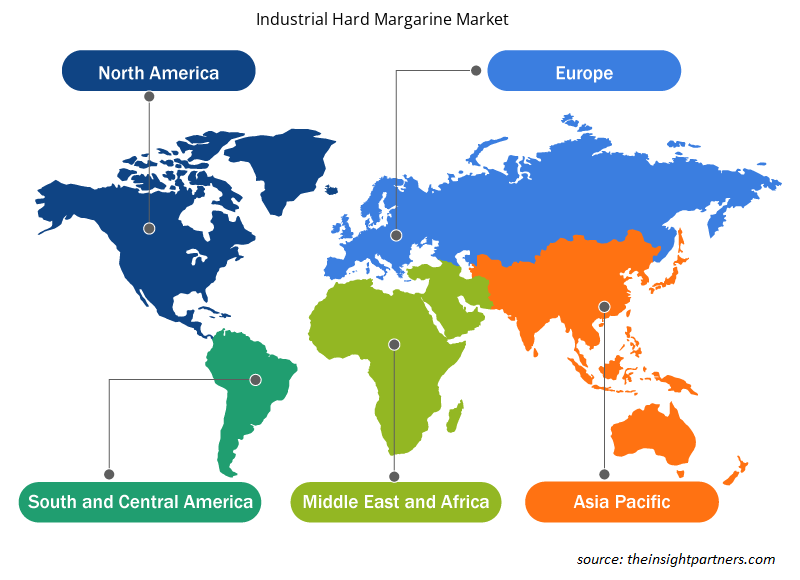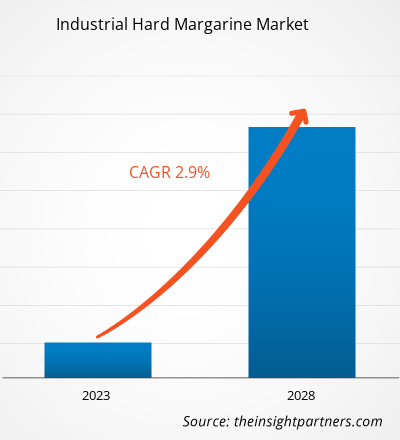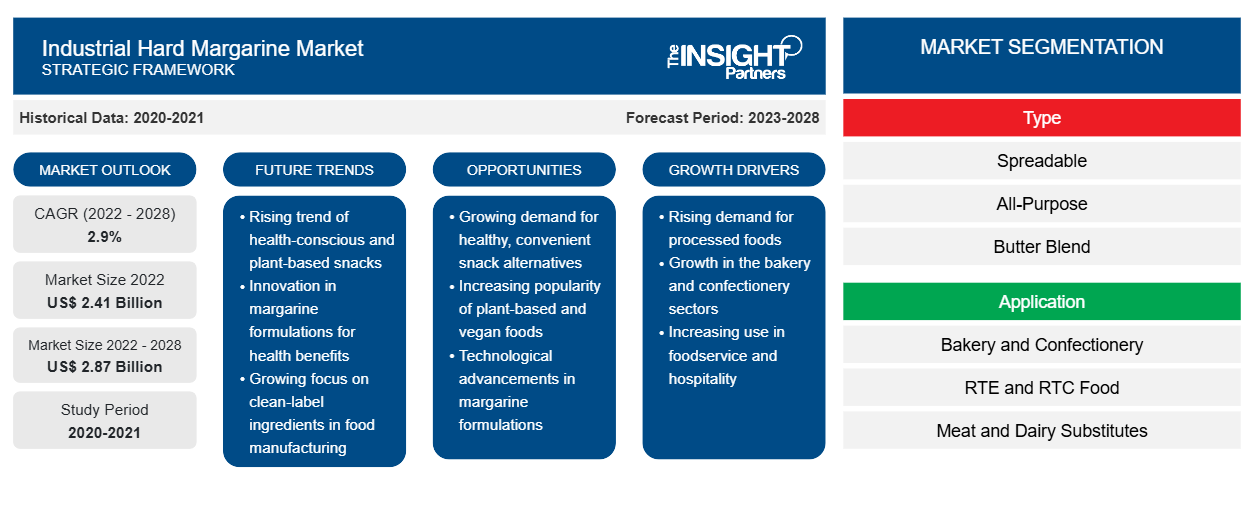Der Markt für industrielle Hartmargarine soll von 2.414,51 Millionen US-Dollar im Jahr 2022 auf 2.869,63 Millionen US-Dollar im Jahr 2028 wachsen; für den Zeitraum von 2022 bis 2028 wird eine durchschnittliche jährliche Wachstumsrate (CAGR) von 2,9 % erwartet.
Margarine wird durch Hydrierung von Pflanzenölen wie Palmöl, Sonnenblumenöl, Rapsöl und Distelöl hergestellt. Im Allgemeinen hat Hartmargarine einen höheren Gehalt an gesättigten Fettsäuren als andere Margarinearten, wie z. B. weiche Margarine/Schalenmargarine und flüssige Margarine. Die steigende Nachfrage nach Hartmargarine in der Lebensmittel- und Getränkeindustrie für Back- und Süßwarenanwendungen treibt den Markt erheblich an. Darüber hinaus treibt der steigende Verbrauch verpackter Backwaren aufgrund veränderter Lebensstile und sich entwickelnder Verbraucherpräferenzen den Markt für industrielle Hartmargarine an.
Im Jahr 2022 hatte Nordamerika den größten Anteil am Markt für industrielle Hartmargarine. Der Markt im asiatisch-pazifischen Raum wird im Prognosezeitraum voraussichtlich mit der höchsten durchschnittlichen jährlichen Wachstumsrate wachsen. Aufgrund der zunehmenden Häufigkeit von Krankheiten wie Diabetes, Bluthochdruck und Verstopfung tendieren die Verbraucher zu einem gesunden Lebensstil und bevorzugen Produkte, die gesundheitliche Vorteile bieten. Laut den Centers for Diseases Control and Prevention (CDC) litten im Jahr 2021 37,3 Millionen Menschen in den USA an Diabetes. Darüber hinaus ist die Nachfrage nach pflanzlichen Lebensmitteln bei der jungen Bevölkerung gestiegen, was das Wachstum des Marktes für industrielle Hartmargarine ankurbelt. Darüber hinaus verwendet die etablierte Lebensmittelverarbeitungsindustrie in der Region industrielle Hartmargarine zur Herstellung mehrerer Lebensmittelprodukte. Wichtige Lebensmittelhersteller in der Region konzentrieren sich auf die Einführung kostengünstiger Alternativen zu Butter, was die Nachfrage nach industrieller Hartmargarine ankurbelt.
Passen Sie diesen Bericht Ihren Anforderungen an
Sie erhalten kostenlose Anpassungen an jedem Bericht, einschließlich Teilen dieses Berichts oder einer Analyse auf Länderebene, eines Excel-Datenpakets sowie tolle Angebote und Rabatte für Start-ups und Universitäten.
-
Holen Sie sich die wichtigsten Markttrends aus diesem Bericht.Dieses KOSTENLOSE Beispiel umfasst eine Datenanalyse von Markttrends bis hin zu Schätzungen und Prognosen.
Auswirkungen der COVID-19-Pandemie auf den Markt für industrielle Hartmargarine
Die COVID-19-Pandemie hat die Wirtschaft und Industrie in verschiedenen Ländern auf der ganzen Welt beeinflusst. Lockdowns, Reisebeschränkungen und Betriebsschließungen in Nordamerika, Europa, Asien-Pazifik (APAC), Süd- und Mittelamerika sowie dem Nahen Osten und Afrika (MEA) behinderten das Wachstum mehrerer Branchen, darunter auch der Lebensmittel- und Getränkeindustrie. Die Schließung von Produktionseinheiten unterbrach globale Lieferketten, Fertigungsaktivitäten, Lieferpläne sowie den Verkauf lebenswichtiger und nicht lebenswichtiger Produkte. Verschiedene Unternehmen erlebten im Jahr 2020 Verzögerungen bei der Produktlieferung und einen Einbruch der Verkäufe ihrer Produkte. Darüber hinaus zwangen die von den Regierungen verschiedener Länder in Europa, Asien-Pazifik (APAC) und Nordamerika verhängten Verbote für internationale Reisen die Unternehmen dazu, ihre Kooperations- und Partnerschaftspläne vorübergehend einzustellen. All diese Faktoren behinderten verschiedene Branchen im Jahr 2020 und Anfang 2021 und bremsten damit das Wachstum verschiedener Märkte, darunter auch des Marktes für industrielle Hartmargarine .
Die steigende Nachfrage nach Margarine als kostengünstige Alternative zu Butter, der wachsende Bedarf der Lebensmittelindustrie in Schwellenländern an Margarine und die zunehmende Begeisterung der Verbraucher für einen gesunden Lebensstil waren die Schlüsselfaktoren, die das Wachstum des Marktes für industrielle Hartmargarine ankurbelten. Vor dem Ausbruch von COVID-19 wurde der Markt für industrielle Hartmargarine auch durch den steigenden Konsum von Backwaren und die wachsende Nachfrage der Lebensmittelhersteller nach erschwinglichen, nachhaltigen und gesünderen Zutaten angetrieben. Nach dem Ausbruch der COVID-19-Pandemie im Jahr 2020 standen die Branchen jedoch vor beispiellosen Herausforderungen, darunter Lieferkettenbeschränkungen aufgrund landesweiter Lockdowns, Handelsverbote und Reisebeschränkungen. Die Unterbrechungen der Lieferketten führten zu einem Mangel an Rohstoffen, der die Produktion und den Vertrieb verschiedener Produkte beeinträchtigte und zu höheren Preisen führte.
Im Jahr 2021 nahmen viele Volkswirtschaften ihren Betrieb wieder auf, da die Regierungen mehrerer Länder Lockerungen der zuvor verhängten Beschränkungen ankündigten, was dem globalen Markt Auftrieb gab. Darüber hinaus durften die Hersteller mit voller Kapazität arbeiten, was ihnen half, die Lücke zwischen Angebot und Nachfrage sowie andere Auswirkungen zu überwinden.
Darüber hinaus hatte die COVID-19-Pandemie einen langfristigen positiven Einfluss auf den Markt für industrielle Hartmargarine, da die Lebensmittelverarbeitungsindustrie aufgrund der steigenden Nachfrage nach verarbeiteten Lebensmitteln und Fertiggerichten ein bemerkenswertes Wachstum verzeichnete. Der zunehmende Einsatz industrieller Hartmargarine durch Lebensmittelhersteller als Ersatz für Butter durch einen Ersatz mit niedrigem Transfettgehalt trieb das Marktwachstum an. Die Verbraucher tendierten zu einem gesunden Lebensstil und nahmen aufgrund der steigenden Zahl von COVID-19-Patienten vermehrt gesunde Lebensmitteloptionen an. Aufgrund der COVID-19-Pandemie achten die Verbraucher zunehmend auf ihre Gesundheit und ihr Wohlbefinden. Darüber hinaus erlebte der Markt eine erhöhte Nachfrage nach Lebensmitteln mit hochreinen Zutaten, was den Verkauf von industrieller Hartmargarine ankurbelte. Da sich die Verbraucher während der Pandemie verstärkt auf die Suche nach gesünderen Alternativen konzentrierten, stieg auch der Bedarf an industrieller Hartmargarine weltweit.
Markteinblicke
Strategische Entwicklungen der Hauptakteure begünstigen das Wachstum des Marktes für industrielle Hartmargarine
Im Juni 2022 erwarb AAK AB die auf Aquafaba basierende pflanzliche Marke „Butter“ für A: Butter: Sie kann als 1:1-Ersatz für Milchbutter dienen. Darüber hinaus kündigte Bunge Loders Croklaan, das pflanzliche Lipidunternehmen von Bunge (NYSE: BG), im Juni 2021 den Plan an, im Hafen von Amsterdam eine hochmoderne, nachhaltige Produktionsanlage zu errichten. Solche strategischen Entwicklungen durch wichtige Marktteilnehmer dürften das Wachstum des Marktes für industrielle Hartmargarine in den kommenden Jahren vorantreiben.
Typ-Einblicke
Der Markt für industrielle Hartmargarine ist nach Typ in Streichmargarine, Allzweckmargarine und Buttermischung unterteilt. Das Allzwecksegment hatte 2022 den größten Marktanteil, und das Streichmargarinesegment wird im Prognosezeitraum voraussichtlich die höchste durchschnittliche jährliche Wachstumsrate verzeichnen. Streichmargarine ist eine weiche Margarine in der Wanne, die mit weniger gehärteten und flüssigeren Ölen als Blockmargarine hergestellt wird. Sie besteht typischerweise aus Pflanzenölen. Streichmargarine hat verschiedene Anwendungen, von verzehrfertigen Produkten wie Toastsandwiches und Kuchen bis hin zur Herstellung von Biskuit. Hersteller bieten Streichmargarine mit unterschiedlichem Fettgehalt an, die als fettreiche, mittelfette, fettarme und sehr fettarme Aufstriche kategorisiert werden. Die fettarmen und sehr fettarmen Aufstriche werden für verzehrfertige Produktanwendungen entwickelt. Der Markt für industrielle Hartmargarine erlebt mehrere Trends, darunter die Entwicklung von aromatisierten Aufstrichen, Diätaufstrichen und ausgewogenen Aufstrichen.
Regionale Einblicke in den Markt für industrielle Hartmargarine
Die regionalen Trends und Faktoren, die den Markt für industrielle Hartmargarine während des gesamten Prognosezeitraums beeinflussen, wurden von den Analysten von Insight Partners ausführlich erläutert. In diesem Abschnitt werden auch die Marktsegmente und die Geografie für industrielle Hartmargarine in Nordamerika, Europa, im asiatisch-pazifischen Raum, im Nahen Osten und Afrika sowie in Süd- und Mittelamerika erörtert.

- Erhalten Sie regionale Daten zum Markt für industrielle Hartmargarine
Umfang des Marktberichts über industrielle Hartmargarine
| Berichtsattribut | Details |
|---|---|
| Marktgröße im Jahr 2022 | 2,41 Milliarden US-Dollar |
| Marktgröße bis 2028 | 2,87 Milliarden US-Dollar |
| Globale CAGR (2022 - 2028) | 2,9 % |
| Historische Daten | 2020-2021 |
| Prognosezeitraum | 2023–2028 |
| Abgedeckte Segmente |
Nach Typ
|
| Abgedeckte Regionen und Länder |
Nordamerika
|
| Marktführer und wichtige Unternehmensprofile |
|
Dichte der Marktteilnehmer für industrielle Hartmargarine: Verständnis ihrer Auswirkungen auf die Geschäftsdynamik
Der Markt für industrielle Hartmargarine wächst rasant, angetrieben durch die steigende Endverbrauchernachfrage aufgrund von Faktoren wie sich entwickelnden Verbraucherpräferenzen, technologischen Fortschritten und einem größeren Bewusstsein für die Vorteile des Produkts. Mit steigender Nachfrage erweitern Unternehmen ihr Angebot, entwickeln Innovationen, um die Bedürfnisse der Verbraucher zu erfüllen, und nutzen neue Trends, was das Marktwachstum weiter ankurbelt.
Die Marktteilnehmerdichte bezieht sich auf die Verteilung der Firmen oder Unternehmen, die in einem bestimmten Markt oder einer bestimmten Branche tätig sind. Sie gibt an, wie viele Wettbewerber (Marktteilnehmer) in einem bestimmten Marktraum im Verhältnis zu seiner Größe oder seinem gesamten Marktwert präsent sind.
Die wichtigsten auf dem Markt für industrielle Hartmargarine tätigen Unternehmen sind:
- Vandemoortele NV
- Bunge Ltd
- Puratos NV
- NMGK-Gruppe von Co
- Fuji Oil Co Ltd
Haftungsausschluss : Die oben aufgeführten Unternehmen sind nicht in einer bestimmten Reihenfolge aufgeführt.

- Überblick über die wichtigsten Akteure auf dem Markt für industrielle Hartmargarine
Anwendungseinblicke
Basierend auf der Anwendung ist der Markt für industrielle Hartmargarine in Bäckereien und Süßwaren, RTE- und RTC-Lebensmittel, Fleisch- und Milchersatzprodukte und andere unterteilt. Das Segment Bäckereien und Süßwaren ist in Kekse und Biskuits, Kuchen, Blätterteiggebäck und andere Back- und Süßwaren unterteilt. Das Segment Bäckereien und Süßwaren hatte 2022 den größten Marktanteil und wird im Prognosezeitraum voraussichtlich die höchste CAGR verzeichnen. Die steigende Kaufkraft und die veränderten Essgewohnheiten der Menschen haben zu einer zunehmenden Beliebtheit von Back- und Süßwarenprodukten bei den Massen geführt. Backwaren wie Kekse machen einen Großteil der weltweit produzierten Backwaren aus. Der Backwarensektor umfasst Kuchen, Blätterteiggebäck, Tiefkühlbackwaren usw. Hartmargarine ist eine wesentliche Backzutat, da sie für Zartheit, eine verbesserte Textur und ein besseres sensorisches Profil sorgt und den Nährwert von Lebensmitteln erhöht.
Vandemoortele NV, Bunge Ltd, Puratos NV, NMGK Group of Co, Fuji Oil Co Ltd, Wilmar International Ltd, Nubeser Soluciones SLU, Cardowan Creameries Ltd, AAK AB und Eccelso Ltd gehören zu den wichtigsten Akteuren auf dem Markt für industrielle Hartmargarine. Diese Unternehmen konzentrieren sich hauptsächlich auf Produktinnovationen, um ihren Marktanteil zu vergrößern und neuen Trends zu folgen.
Bericht-Spotlights
- Fortschrittliche Branchentrends auf dem Markt für industrielle Hartmargarine helfen Unternehmen bei der Entwicklung wirksamer langfristiger Strategien
- Von Marktteilnehmern in Industrie- und Entwicklungsländern verfolgte Strategien für Unternehmenswachstum
- Quantitative Analyse des Marktes von 2022 bis 2028
- Schätzung der weltweiten Nachfrage nach industrieller Hartmargarine
- Porters Fünf-Kräfte-Analyse zur Veranschaulichung der Wirksamkeit von Käufern und Lieferanten auf dem Markt für industrielle Hartmargarine
- Aktuelle Entwicklungen zum Verständnis des wettbewerbsorientierten Marktszenarios
- Markttrends und -aussichten sowie Wachstumstreiber und -hemmnisse auf dem Markt für industrielle Hartmargarine
- Unterstützung im Entscheidungsprozess durch Aufzeigen von Marktstrategien, die das kommerzielle Interesse untermauern
- Größe des Marktes für industrielle Hartmargarine an verschiedenen Knotenpunkten
- Detaillierte Übersicht und Segmentierung des Marktes und der Wachstumsdynamik der industriellen Hartmargarineindustrie
- Größe des Marktes für industrielle Hartmargarine in verschiedenen Regionen mit vielversprechenden Wachstumschancen
- Historische Analyse (2 Jahre), Basisjahr, Prognose (7 Jahre) mit CAGR
- PEST- und SWOT-Analyse
- Marktgröße Wert/Volumen – Global, Regional, Land
- Branchen- und Wettbewerbslandschaft
- Excel-Datensatz
Aktuelle Berichte
Erfahrungsberichte
Grund zum Kauf
- Fundierte Entscheidungsfindung
- Marktdynamik verstehen
- Wettbewerbsanalyse
- Kundeneinblicke
- Marktprognosen
- Risikominimierung
- Strategische Planung
- Investitionsbegründung
- Identifizierung neuer Märkte
- Verbesserung von Marketingstrategien
- Steigerung der Betriebseffizienz
- Anpassung an regulatorische Trends























 Kostenlose Probe anfordern für - Markt für industrielle Hartmargarine
Kostenlose Probe anfordern für - Markt für industrielle Hartmargarine